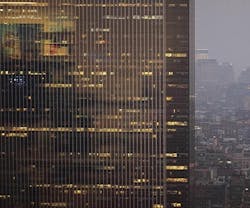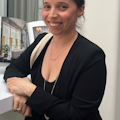Interiors & Sources: Tell us about your background.
Shuli Sadé: I am an interdisciplinary artist. I was trained as a visual artist and have been greatly inspired by architecture and design. I’ve taught classes at several A&D schools, including Parsons, the School of Architecture at the University of Pennsylvania, and the School of Architecture at Bezalel Academy of Art and Design.
IS: How did you end up in such a specialized nook of the art world?
SS: My interest in spatial perception and structural geometry makes architecture a great source of inspiration for my process. As a multi-disciplinary artist I often mix two and three dimensional concepts, alternating between photography, video, drawings, objects, and installation. Sculpting and building architectural models had given me some confidence with creating functional objects. Certain projects allow me to experiment with larger scale fabrications and give me the opportunity to collaborate with professional makers outside of the artist studio. I believe that’s what I was aiming for all along: collaborating with architects, designers, fabricators, and overall innovative clients on large-scale art projects related to specific places.
IS: How do you think your work lends itself to interior design?
SS: I think I like and understand the combination of both the functional and aesthetic sides of art. Working with interior designers and architects strengthens my ability to integrate more conceptual considerations into my art rather than just the purely aesthetic ones.
IS: How did you come to investigate “encoded memory” (which you explore in your Reconfiguring Memory series)?
SS: My interest in memory grew in the past decade. I worked closely with neural scientists inspired by their discoveries and methods of research of the brain and memory in particular. Made of particles, the photograph makes marks on a certain time in space. Codes are marks, a vocabulary of signs making an entire language. Early teletype machines were used to transport coded messages which needed to be decoded by the receiver. In coding and decoding there must be a sender and receiver. An artwork needs to be read by the viewer. I began to remove information from the photographs examining how far can I go with missing particles in order to be able to read the image.
Working with these particles is like looking at an image through a huge magnifying glass. Photography is a tool that we use to remember. In this digital age we all relate to memory on a daily basis, storing or retrieving information from the past. Along with encoding and storage, recall is one of the three core processes of memory. Memory is the recollection of events or the ability of the mind or of an individual or organism to retain learned information and knowledge of past events and experiences and to retrieve it.
IS: Tell us about the process of building the conference table built from an encoded memory photograph installed at the Center for Neural Science at New York University.
SS: Reconfiguring Memory is a permanent art installation at the Center for Neural Science at Neurobiology of Cognition Laboratory at NYU. It includes three elements, one of which is the Encode/Decode conference table made of Galaxy Glass & Stone, stainless steel, and a photograph. I removed and retrieved memory from a night shot of Midtown Manhattan, taken from the 38th floor of the Renzo Piano-designed New York Times building. The total glass weight was a half-ton, placed on brushed stainless steel. An international group of neural scientists use the laboratory, where the conference table is the hub for exchanging new ideas. Reconfiguring Memory is an artistic affirmation that the best science is not conducted in isolation and through a microscope, but often through collaboration and the exchange of ideas.
IS: In your photography practice, why did you take to shooting at night?
SS: My fascination with urban grids is heightened at night. Architecture and streets are reshaped in darkness. Color is reduced to black and white, negative and positive. A new urban system reflects a differently shaped city. In recent years I have worked with physical and digital memory, often comparing the grid in the brain to an urban map.
IS: Tell us about your Engram drawings:
SS: Engrams are a hypothetical means by which memory traces are stored as biophysical or biochemical changes in the brain (and other neural tissue) in response to external stimuli. The Engram Drawings are urban palimpsests systematically hand drawn with ink on draft film (60 x 110). Following a radical digital reduction of content I examine my own memory of the scene I had photographed by a refined repetition of geometries. Various memories spring up; forgetfulness makes its mark. The act of drawing brings back a physical methodical recording of the digitally eliminated memory.
IS: What are decoded photographs exactly and how do you decide which parts to deconstruct, so to speak?
SS: Decoded-encoded photographs are cityscapes investigating memory loss and retrieval. These urban manuscripts form ghostly texts as overwritten, erased, and retrieved images that collapse time—eradicating, transforming, and rebuilding space. The geometry of missing particles unveils a grid of architectural rhythms that belong to large modern cities. Removing photographic information with a mechanical precision creates a new landscape, constructed from lost evidence within an existing landscape. The process of removal and recall of pixels from the original photograph is made digitally, randomly, or in order, either following the composed memory methodically or my own memory path while removing the pixels. Instead of working with an algorithm, I create manual removal systems.
IS: Can you tell us a little bit about your latest project, Imprints?
SS: Imprints is a permanent, 65-foot art installation of custom laminated annealed glass composites and photographic film interlayers placed in the reception area of the Cozen O’Connor law firm’s international headquarters, designed by Gensler, in the heart of Philadelphia’s Central Business District.
The level of transparency of the Galaxy Glass & Stone panels was carefully selected to create visibility for the movement behind the glass, signifying an infinite river-like flow and momentum, reflecting the two rivers bordering the city on both sides. Imprints magnifies the space while capturing the energy of the city. I took 17 photographs from the 57th floor of the building that channeled views of the cityscapes and placed them in a centrifugal rotation of 360 degrees to create the images. Imprints heightens awareness and links viewers and visitors from within the space outwards, to the surrounding landscapes. This awareness maintains a balance between reality and metaphor, between the present and its memory, and creates a meditative ambiance reflecting an aura of the city from above.
About the Author
AnnMarie Martin
Editor-in-Chief
AnnMarie is the former Editor in Chief of i+s and has been covering the commercial design space. Her style and vision has helped the brand evolve into a thought leader in purpose-driven design and cultural movements shaping the way we live and work.

